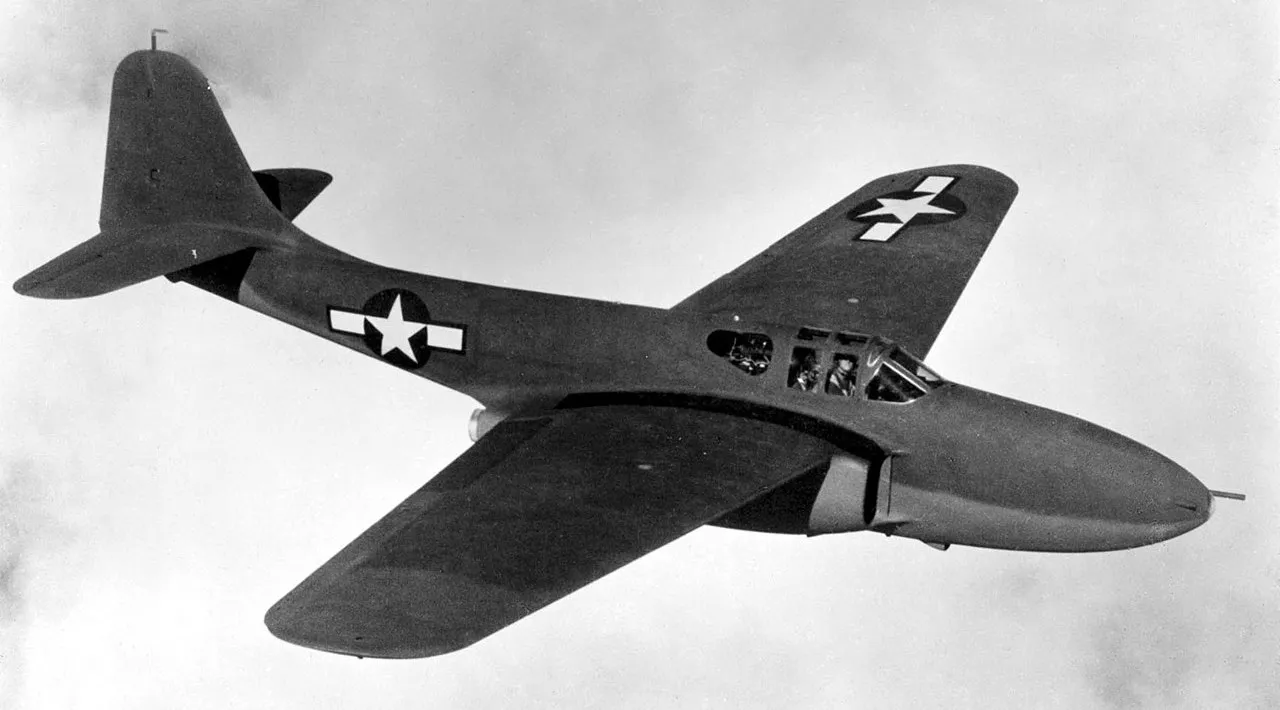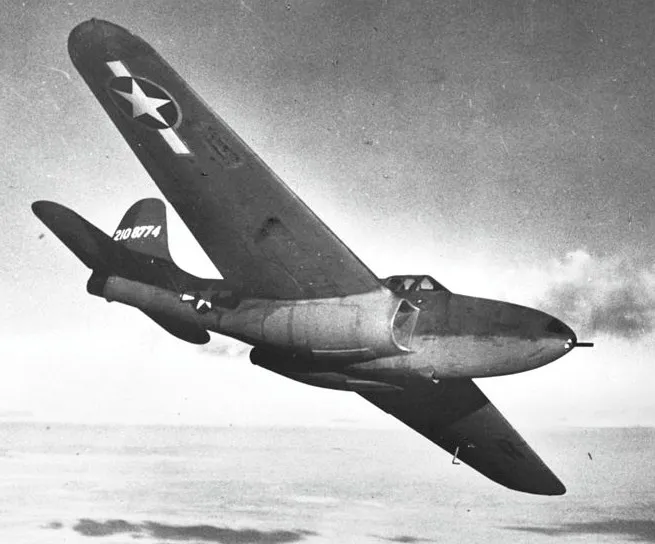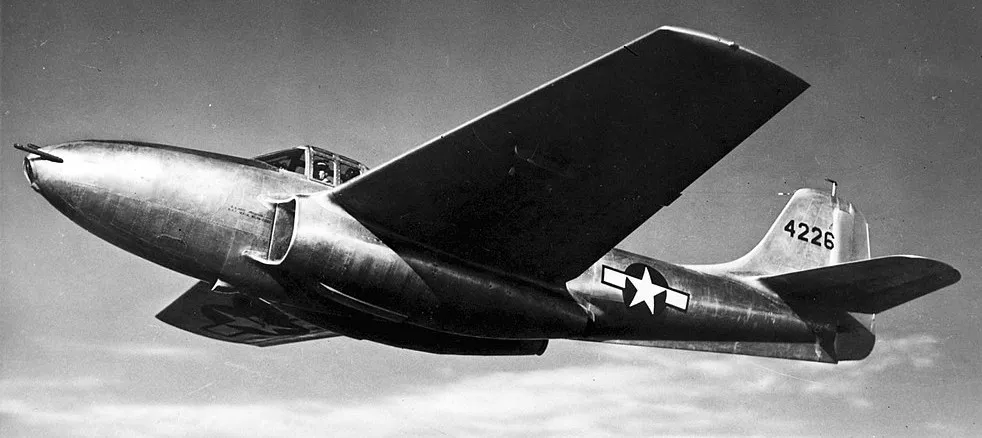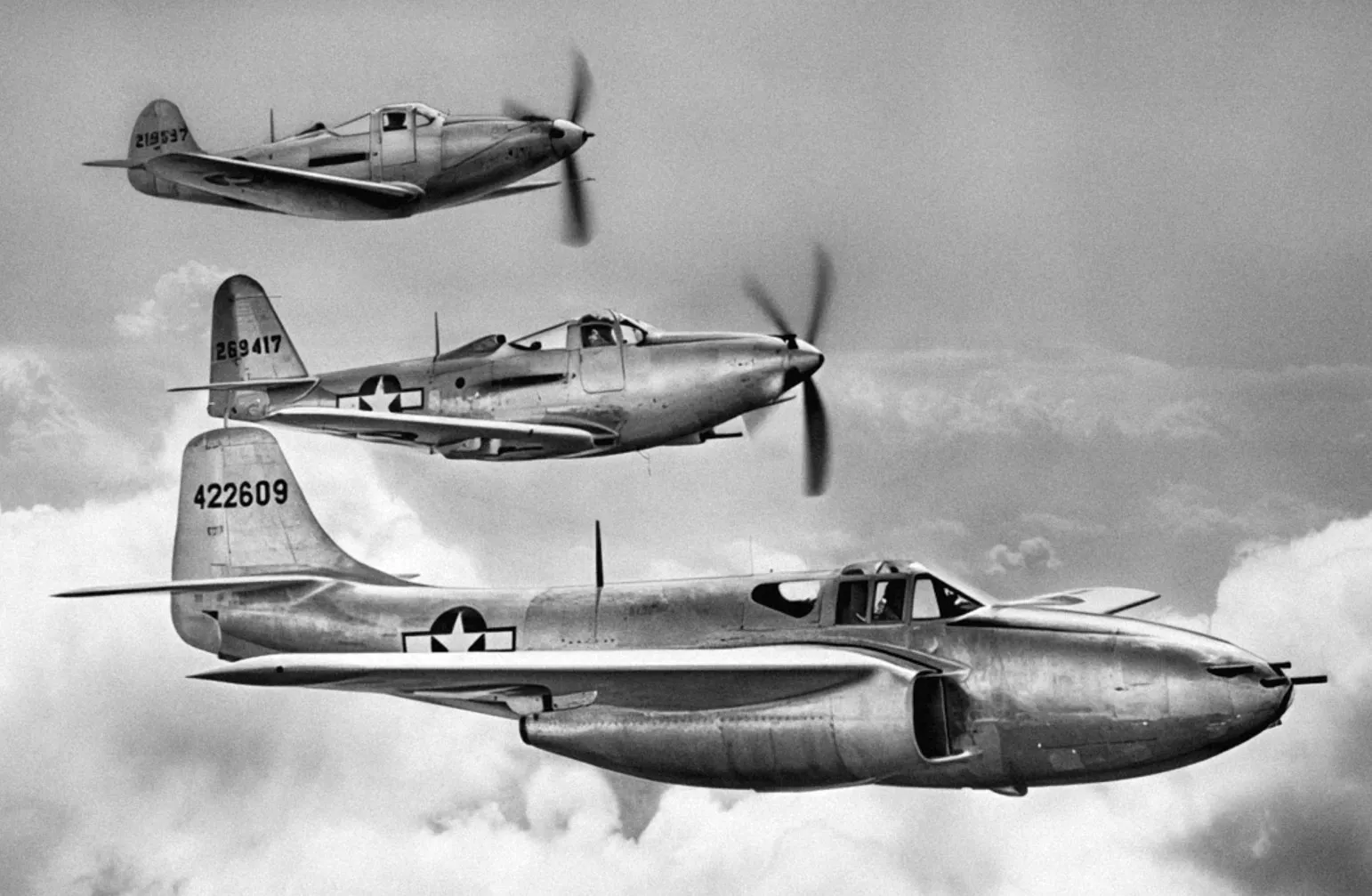Warplanes of the USA: Bell P-59 Airacomet
Bell P-59 Airacomet
The aim of this website is to locate, identify and document Warplanes from the Second World War preserved in the USA. Many contributors have assisted in the hunt for these aircraft to provide and update the data on this website. Photos are as credited. Any errors found here are by the author, and any additions, corrections or amendments to this list of Warplane Survivors of the Second World War in the United States of America would be most welcome and may be e-mailed to the author at [email protected].

(USAF Photo)
Bell YP-59A Airacomet (Serial No. 42-108777).
The Bell P-59 Airacomet is a single-seat, twin jet-engine fighter aircraft that was designed and built by Bell Aircraft during World War II. It was the first jet produced in the United States. As the British were further along in jet engine development, they donated an engine for the United States to copy in 1941 that became the basis for the General Electric J31 jet engine used by the P-59 a year later. Because the plane was underpowered, the United States Army Air Forces (USAAF) was not impressed by its performance and canceled half of the original order for 100 fighters, using the completed aircraft as trainers. The USAAF would instead go on to select the Lockheed P-80 Shooting Star as its first operational jet fighter. Although no P-59s entered combat, the aircraft paved the way for later generations of U.S. turbojet-powered aircraft.

(USAAF Photo)
The Bell XP-59A, America’s first turbojet-powered airplane. On October 1, 1942, as Bell test pilot Bob Stanley completed the final series of high-speed taxi tests, the aircraft's wheels lifted off from the surface of Rogers Dry Lake and, for the first time, an American turbojet became airborne. The official first flight took place on 2 October.
.webp)
(NASA Glenn Research Center Photo)
The secret test of the Bell YP–59A Airacomet in the spring of 1944 was the first investigation in the National Advisory Committee for Aeronautics (NACA) Aircraft Engine Research Laboratory’s new Altitude Wind Tunnel (AWT). The Airacomet, powered by two General Electric I–A centrifugal turbojets, was the first US jet aircraft. The Airacomet’s 290-miles per hour speed, however, was dwarfed by the German Messerschmitt Me-262 Schwalbe’s 540 miles per hour. In 1941 and 1942 General Electric built the first US jet engines based on technical drawings from British engineer Frank Whittle. Bell Aircraft was contracted to produce an airframe to incorporate the new engines. The result was the Bell XP–59A Airacomet. The aircraft made its first flight over Muroc Lake, California, on October 2, 1942. The aircraft continued to struggle over the next year and the NACA was asked to test it in the new AWT. A Bell YP–59A was flown from the Bell plant in Buffalo to Cleveland by Bob Stanley, who had piloted the first successful flight of the XP–59A at Muroc in 1942. The wing tips and tail were cut from the aircraft so that it would fit into the AWT’s test section. The study first analyzed the engines in their original configuration and then implemented a boundary layer removal duct, a new nacelle inlet, and new cooling seals. Tests of the modified version showed that the improved airflow distribution increased the I–16’s performance by 25 percent. Despite the improved speed, the aircraft was not stable enough to be used in combat, and the design was soon abandoned.

(USAAF Photo)
A U.S. Army Air Forces Bell YP-59A-BE Airacomet (Serial No. 42-108774) in flight near the Muroc Flight Test Base (North Base).
.webp)
(Bill Larkins Photo)
Bell YP-59A, Wright Field October 1945.

(American Aviation Historical Society Photo)
Bell YP-59A-1 Airacomet.

(USN Photo)
A U.S. Army Air Forces Bell P-59 Airacomet at the Naval Air Test Center Patuxent River, Maryland, on 26 January 1944.

(USAAF Photo)
Bell XP-59A 3/4 rear view. Note the bars have been painted onto the National Insignia of this image. The original National Insignia appearing on the image was the star on blue circle.
.webp)
(SDASM Photo)
:Bell YP-59A (Serial No. 42-108775), Wright Field, Ohio.

(USAAF Photo)
A U.S. Army Air Forces Bell XP-59A Airacomet (s/n 42-108784) at Muroc Dry Lake, California. The XP-59A made its first flight on 2 October 1942.

(USAF Photo)
Bell P-59B Airacomet (Serial No. 44-22633), Edwards AFB, California.
.webp)
(USAF Photo)
Bell P-59A Airacomet (Serial No. 44-22614) at Hancock College of Aeronautics, Santa Maria, California in August 1949.

(USAF Photo)
Bell P-59B Airacomet (Serial No. 44-22656), Pioneer Village, Minden, Nebraska.
.webp)
(SDASM Archives Photo)
Airacomet Bell P-59A Airacomet (Serial No. 44-22609) with a Bell P-63 in formation.
.webp)
(SDASM Archives Photo)
Airacomet Bell P-59A Airacomet (Serial No. 44-22609).
.webp)
(SDASM Archives Photo)
Airacomet Bell P-59A Airacomet (Serial No. 44-22635).

(USAAF Photo)
Bell P-39, P-63 and P-59 in formation.
.avif)
(Tomas Del Coro Photo)
Bell YP-59A Airacomet (Serial No. 42-108777), being restored to flying condition with General Electric J31 engines by Planes of Fame Museum, Chino, California.

.avif)
(Alan Wilson Photos)
Bell P-59A Airacomet (Serial No. 44-22614), c/n 27-22, March Field Air Museum, Riverside, California.

(kitmasterbloke Photo)
Bell P-59A Airacomet (Serial No. 44-22614), c/n 27-22, March Field Air Museum, Riverside, California.

(Greg Goebel Photo)
Bell XP-59A Airacomet (Serial No. 42-108784), National Air & Space Museum, Washington, D.C.
.webp)
(NASA Glenn Research Center Photo)
A Bell P-59B Airacomet sits beside the hangar at the National Advisory Committee for Aeronautics (NACA) Lewis Flight Propulsion Laboratory. In 1942 the Bell XP-59A Airacomet became the first jet aircraft in the US. The Airacomet incorporated centrifugal turbojet engines that were based on British plans secretly brought to the US in 1941. A Bell test pilot flew the XP-59A for the first time at Muroc Lake, California in October 1942. The General Electric I-16 engines proved to be problematic. In an effort to increase the engine performance, an Airacomet was secretly brought to Cleveland in early 1944 for testing in the Altitude Wind Tunnel. A series of tunnel investigations in February and March resulted in a 25-percent increase in the I-16 engine’s performance. Nonetheless, Bell’s 66 Airacomets never made it into combat. A second, slightly improved Airacomet, a P-59B, was transferred to NACA Lewis just after the war in September 1945. The P-59B was used over the next three years to study general jet thrust performance and thrust augmentation devices such as afterburners and water/alcohol injection. The P-59B flights determined the proper alcohol and water mixture and injection rate to produce a 21-percent increase in thrust. Since the extra boost would be most useful for takeoffs, a series of ground-based tests with the aircraft ensued. It was determined that the runway length for takeoffs could be reduced by as much as 15 percent. The P-59B used for the tests is now on display at the Air Force Museum at Wright Patterson.

(NMUSAF Photo)
Bell P-59B Airacomet (Serial No. 44-74936), painted as (Serial No. 44-22650), C/N 27-58. National Museum of the United States Air Force, Dayton, Ohio.
.avif)
(Judson McCranie Photo)
Bell P-59B Airacomet (Serial No. 44-74936), painted as (Serial No. 44-22650), C/N 27-58. National Museum of the United States Air Force, Dayton, Ohio.
.avif)
(ZLEA Photo)
Bell P-59B-1-BE Airacomet at the National Museum of the United States Air Force.

(USAF Photo)
Development of the Bell P-59 Airacomet, America's first jet-propelled airplane, was ordered personally by General H. H. Arnold on 4 September 1941. The project was conducted under the utmost secrecy, with Bell building the airplane and General Electric the engine. The first P-59 was completed in mid-1942 and on 1 October 1942, it made its initial flight at Muroc Dry Lake (now Edwards Air Force Base), California. One year later, the airplane was ordered into production, to be powered by I-14 and I-16 engines, improved versions of the original I-A. Bell produced 66 P-59s. Although the airplane's performance was not spectacular and it never got into combat, the P-59 provided training for AAF personnel and invaluable data for subsequent development of higher performance jet airplanes.

(USAAF Photo)
Bell P-59 Airacomet.





